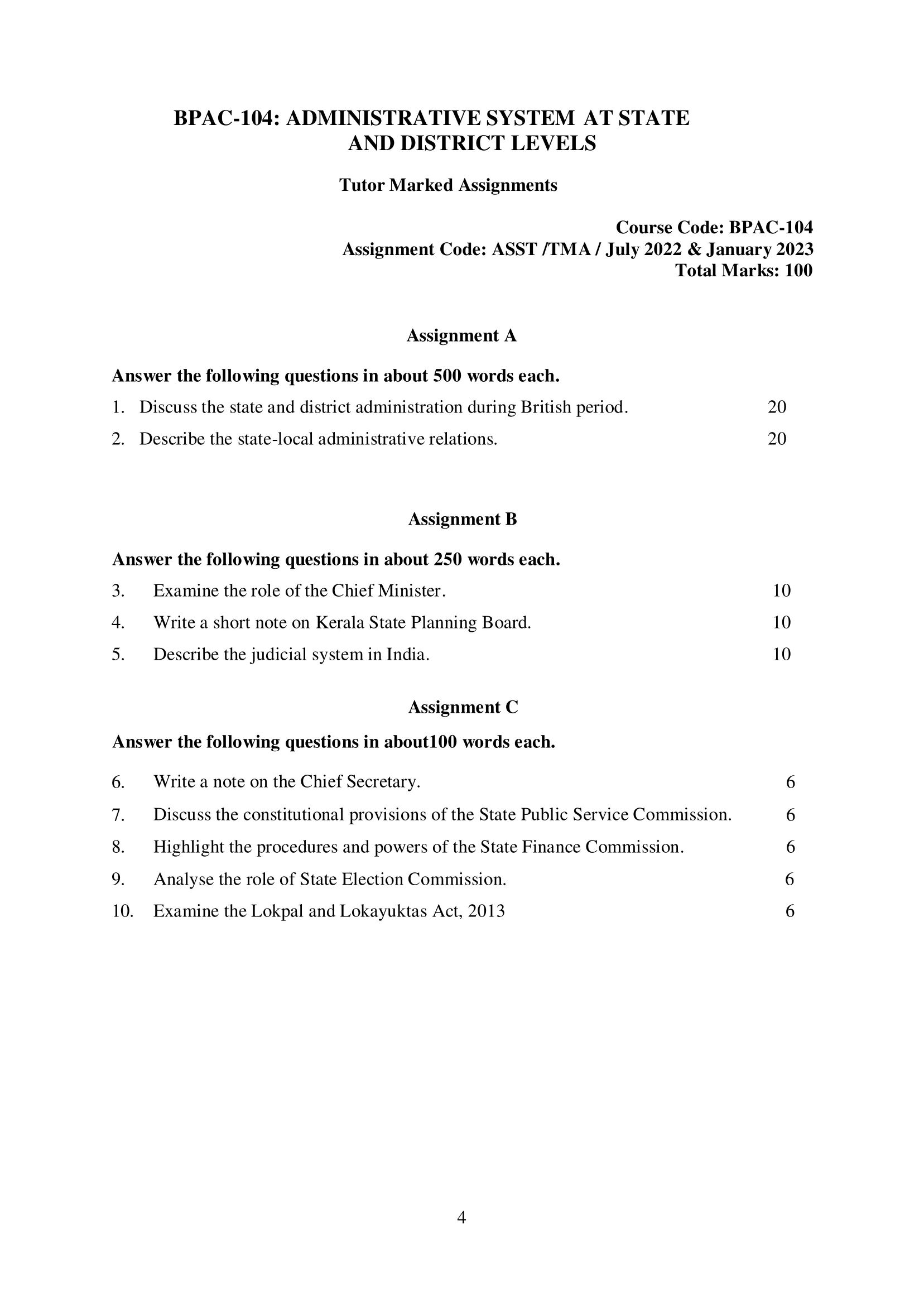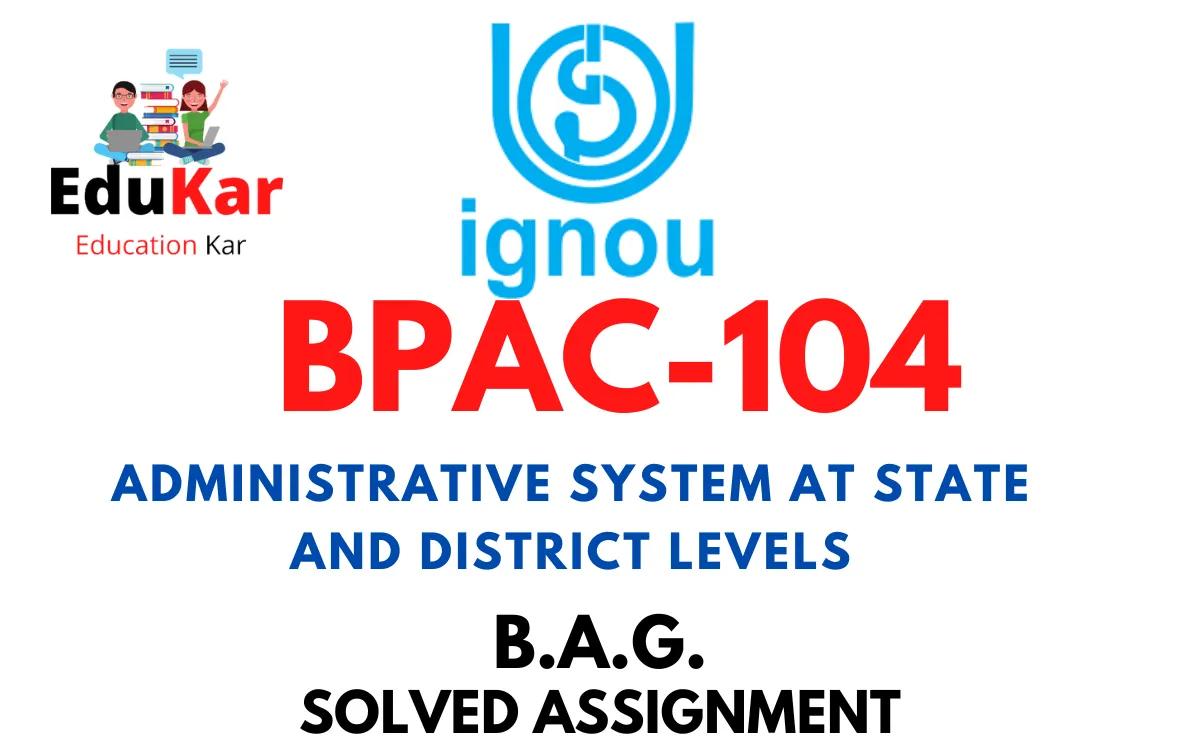
| Title | BPAC-104: IGNOU BAG Solved Assignment 2022-2023 |
| University | IGNOU |
| Degree | Bachelor Degree Programme |
| Course Code | BPAC-104 |
| Course Name | ADMINISTRATIVE SYSTEM AT STATE AND DISTRICT LEVELS |
| Programme Name | Bachelor of Arts (General) |
| Programme Code | BAG |
| Total Marks | 100 |
| Year | 2022-2023 |
| Language | English |
| Assignment Code | ASST/TMA/July 2022 & January 2023 |
| Assignment PDF | Click Here |
| Last Date for Submission of Assignment: | For June Examination: 31st April For December Examination: 30th September |

Assignment A
Answer the following questions in about 500 words each.
1. Discuss the state and district administration during British period.
Ans: During the British period, the administration of India was divided into two main levels: central and local. The central government was responsible for matters that affected the entire country, such as foreign relations, defense, and monetary policy. The local government was responsible for the administration of the provinces and districts.
State Administration: The British India was divided into several provinces, each of which had a Governor as the head of the administration. The Governor had vast powers to govern the province and was accountable only to the Secretary of State for India in London. The Governor was assisted by a Council of Ministers who advised him on various matters of governance. Each province was divided into several districts, which were administered by a District Collector. The District Collector was responsible for maintaining law and order, collecting revenue, and implementing government policies in his district.
District Administration: The district was the lowest level of administration during the British period. The District Collector was the head of the district administration. He was responsible for the maintenance of law and order, revenue collection, and implementation of government policies in his district. He was assisted by several subordinate officers like Tahsildars, Kanungos, and Revenue Inspectors who helped him in the discharge of his duties. The District Collector was also responsible for the judicial administration in his district. He was the District Judge and was assisted by several subordinate judges like Munsifs and Subordinate Judges.
The district administration during the British period was highly centralized. The District Collector had vast powers and was accountable only to the Governor. The District Collector had control over all aspects of district administration, including revenue collection, law and order, and judicial administration. The District Collector was also responsible for the implementation of government policies and programs in his district.
One of the most significant features of the British district administration was the introduction of the Zamindari system. The Zamindari system was a revenue collection system that was introduced in the late 18th century. Under this system, the British government granted land rights to Zamindars, who were responsible for collecting revenue from the farmers. The Zamindari system led to the exploitation of the farmers, who were forced to pay exorbitant taxes to the Zamindars. The British government realized the problems of the Zamindari system and tried to abolish it in the 19th century.
2. Describe the state-local administrative relations.
Ans: State-local administrative relations refer to the relationship between state and local governments in the context of administrative governance. In the United States, the Constitution grants state governments the power to create and regulate local governments.
At the state level, the governor, state agencies, and state legislature are responsible for setting policies and regulations that affect local governments. They also provide funding for programs and services that are implemented by local governments, such as education, public safety, and infrastructure.
At the local level, elected officials, such as mayors and city councils, are responsible for implementing state policies and regulations and providing services to their communities. Local governments are also responsible for administering and enforcing their own laws and regulations, such as zoning ordinances and building codes.
The relationship between state and local governments can vary based on the state and the issue at hand. In some cases, there may be a cooperative relationship where state and local governments work together to achieve common goals. In other cases, there may be conflicts or disagreements over issues such as funding, jurisdiction, or policy priorities.
Assignment B
Answer the following questions in about 250 words each.
3. Examine the role of the Chief Minister.
Ans: The Chief Minister is the head of the government in a state in India. The Chief Minister is responsible for running the state administration, implementing government policies, and ensuring the welfare of the people of the state. The Chief Minister is appointed by the Governor of the state, and they are usually the leader of the political party or coalition that has won the majority of seats in the state legislative assembly.
The role of the Chief Minister is multifaceted. Firstly, the Chief Minister is responsible for formulating and implementing policies that benefit the people of the state. This involves working closely with other state officials, bureaucrats, and legislators to ensure that the policies are properly designed, implemented and monitored.
Secondly, the Chief Minister is responsible for maintaining law and order in the state. They have to work with the police and other law enforcement agencies to ensure that the state is safe and secure for the people.
Thirdly, the Chief Minister plays an important role in representing the state on the national stage. They have to work with the central government, other states, and international organizations to promote the state’s interests.
Fourthly, the Chief Minister has a role to play in promoting economic development in the state. This includes attracting investments, creating jobs, and promoting the state’s industries.
Lastly, the Chief Minister has a responsibility to address the concerns and needs of the people of the state. This involves listening to their grievances and taking steps to ensure that their needs are met.
4. Write a short note on Kerala State Planning Board.
Ans: The Kerala State Planning Board is a statutory body constituted by the Government of Kerala in India, which is responsible for formulating and overseeing the implementation of the state’s Five-Year Plans. The Planning Board comprises a Chairman, Vice Chairman, and members, who are appointed by the government.
The Planning Board is responsible for conducting research and analysis to identify the development needs of the state, and for formulating policies and programs to address these needs. It also coordinates and monitors the implementation of various development programs and schemes in the state.
In addition to its primary role in planning and development, the Kerala State Planning Board also works to promote sustainable development and to ensure the participation of all sections of society in the development process. It places a special emphasis on the welfare of marginalized groups and on reducing regional disparities.
5. Describe the judicial system in India.
Ans: The judicial system in India is a hierarchical system that comprises a number of courts at the national, state, and local levels. The system is based on the principle of separation of powers, with the judiciary functioning independently of the executive and legislative branches of the government.
At the national level, the Supreme Court of India is the highest court of the land, with the power of judicial review over all other courts in the country. Below the Supreme Court, there are 25 High Courts in different states and union territories, each with jurisdiction over a particular region.
At the district level, there are subordinate courts such as the District Courts, which are responsible for hearing civil and criminal cases. Additionally, there are specialized courts such as family courts, labor courts, and consumer courts that deal with specific types of cases.
One of the notable features of the Indian judicial system is the presence of a three-tier system of justice delivery at the grassroots level. The lowest tier is made up of Gram Nyayalayas (village courts), which are intended to bring justice to rural areas where people often face difficulties in accessing the regular judicial system. The middle tier consists of Nyay Panchayats (taluk-level courts), which have jurisdiction over a group of villages. The top tier consists of the district courts.
The Indian judicial system follows the adversarial system of justice, in which two opposing parties present their case before a judge who is tasked with determining the truth of the matter. The proceedings are conducted in open court, and both parties have the right to appeal to higher courts if they are dissatisfied with the verdict.
Assignment C
Answer the following questions in about100 words each.
6. Write a note on the Chief Secretary.
Ans: The Chief Secretary is the highest-ranking civil servant in a state or territory in India. They are responsible for the day-to-day administration of the state and work closely with the Chief Minister and other government officials. The Chief Secretary serves as the principal advisor to the Chief Minister on matters of governance, policy, and administration. They also coordinate with other departments and agencies to ensure efficient and effective implementation of government programs and policies. In addition, the Chief Secretary represents the state in negotiations and discussions with the central government and other states. The position of Chief Secretary is a critical one in the Indian administrative system, as they play a key role in shaping policy and implementing programs that impact the lives of citizens.
7. Discuss the constitutional provisions of the State Public Service Commission.
Ans: The Constitution of India provides for the establishment of State Public Service Commissions (SPSC) under Article 315. The SPSC is responsible for conducting recruitment exams and making appointments to the civil services of the state. The Constitution outlines the following provisions for the establishment and functioning of the SPSC:
- Composition: The SPSC should consist of a chairman and other members appointed by the governor of the state. The number of members in the commission is determined by the governor, but it cannot be less than two and more than seven.
- Tenure: The members of the SPSC hold office for a term of six years or until they attain the age of 62 years, whichever is earlier. The chairman of the commission can hold office for a term of six years or until they attain the age of 65 years, whichever is earlier.
- Eligibility: The members of the SPSC should be persons of integrity and have the necessary qualifications and experience to perform their duties. They should not be members of parliament or state legislature, or hold any other office of profit.
- Removal: The members of the SPSC can be removed from their office by the governor on the grounds of misbehavior or incapacity. However, before removing a member, the governor must refer the matter to the Supreme Court for inquiry.
- Powers and functions: The SPSC has the power to conduct examinations for appointments to the civil services of the state and to advise the governor on matters related to the recruitment, promotion, and disciplinary action of civil servants. The SPSC is also responsible for conducting interviews and making recommendations for appointments to higher civil service posts.
8. Highlight the procedures and powers of the State Finance Commission.
Ans: The State Finance Commission (SFC) is a constitutional body established under Article 243I of the Indian Constitution. Its primary role is to make recommendations on the distribution of financial resources between the state government and local bodies, such as municipalities and panchayats. The procedures and powers of the SFC are as follows:
- Composition: The SFC is composed of a chairman and other members appointed by the governor of the state. The chairman is usually a retired judge of the High Court or a person who has served in a senior administrative or financial position in the government.
- Tenure: The members of the SFC hold office for a term of five years and can be eligible for reappointment.
- Powers and functions: The SFC is responsible for making recommendations on the following matters:
- The distribution of financial resources between the state government and local bodies
- The principles for determining the taxes, duties, tolls, and fees that can be assigned to local bodies
- The grants-in-aid that can be given to local bodies from the Consolidated Fund of the state
- The measures to improve the financial position of local bodies
- Procedure: The SFC conducts its proceedings in accordance with the rules framed by the state government. It consults with the state government, local bodies, and other stakeholders before making its recommendations. The SFC also prepares and submits a report to the governor of the state, which is laid before the state legislature.
- Follow-up: The state government is required to consider the recommendations of the SFC and take appropriate action. If the state government does not accept the recommendations, it is required to state the reasons for not accepting them.
9. Analyse the role of State Election Commission.
Ans: The State Election Commission is a constitutional body in India that is responsible for conducting elections to the local bodies, including municipal corporations, municipalities, and panchayats, in the respective states. The State Election Commission is independent of the state government and is responsible for ensuring free and fair elections to the local bodies.
The State Election Commission plays a crucial role in the conduct of local body elections in the state. Its functions include the preparation of electoral rolls, the issuance of election notifications, the scrutiny of nomination papers, and the conduct of the polls. The State Election Commission also supervises the counting of votes and the declaration of results.
In addition to these functions, the State Election Commission is also responsible for ensuring that the entire election process is conducted in a transparent and fair manner. It monitors the conduct of political parties and candidates during the election period and takes action against any violations of the model code of conduct.
The State Election Commission also plays a significant role in ensuring the participation of marginalized sections of society in the local body elections. It is responsible for ensuring that electoral rolls are updated and that the electoral process is inclusive of all sections of society.
10. Examine the Lokpal and Lokayuktas Act, 2013.
Ans: The Lokpal and Lokayuktas Act, 2013, is a landmark legislation in India that was enacted to establish an independent ombudsman called Lokpal at the central level to investigate allegations of corruption against public officials, including the Prime Minister.
The Act provides for the establishment of Lokayuktas in the states, which are similar institutions to the Lokpal at the national level. The Lokayuktas have the power to investigate allegations of corruption against public officials in the state government.
The Lokpal is empowered to receive complaints from the public, conduct preliminary inquiries, and initiate investigations against public officials. The Lokpal has the power to order investigations and prosecute corrupt officials. The Act also provides for protection to whistleblowers and prohibits any retaliatory action against them.
The Lokpal and Lokayuktas Act has been criticized for several reasons, including the lack of a provision for proactive investigation, the exclusion of the judiciary from the purview of the Lokpal, and the limited powers of the Lokayuktas. Additionally, the appointment process of the Lokpal has been criticized for being non-transparent and not independent enough.
Despite these criticisms, the Lokpal and Lokayuktas Act is seen as a significant step in the fight against corruption in India, and has the potential to act as a powerful deterrent against corrupt practices in the government.
How to Download BPAC-104 Solved Assignment?
You can download it from the www.edukar.in, they have a big database for all the IGNOU solved assignments.
Is the BPAC-104 Solved Assignment Free?
Yes this is absolutely free to download the solved assignment from www.edukar.in
What is the last submission date for BPAC-104 Solved Assignment?
For June Examination: 31st April, For December Examination: 30th October





